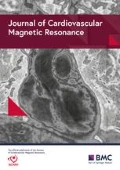Background
Diffuse myocardial fibrosis (DMF) is an important factor in cardiac disease but until recently could only be accurately assessed with biopsy. We hypothesised that DMF measured by EQ-CMR is elevated in isolated systemic hypertension. As such DMF may be a key biomarker in assessing the cardiac effects of systemic hypertension.
Methods
ECV measurement was by EQ-CMR. The T1 mapping sequence was ShMOLLI. The contrast agent was Gadoterate meglumine (Dotarem) at 0.1mmol/Kg (bolus) plus infusion at 15 minutes at 0.0011 mmol/kg/min. CMR was at 1.5T (Siemens Avanto).
ECV was measured in 43 well-controlled hypertensive patients from a specialist tertiary centre (median age 56, range 21 to 78, 55% male) and 50 healthy volunteers (median age 47, range 28 to 69, 58% male).
ECV was calculated by ECV = (1-hematocrit) x (1/T1)myo ÷ (1/T1)blood.
Results
The 43 hypertensive subjects had a significantly higher ECV than the 50 gender-matched normotensive controls (0.274 versus 0.261, p=0.018; Figure 1). Although the mean mass index (85.0g/m2 versus 62.7g/m2) was significantly higher in hypertensive subjects, there was no correlation between ECV and mass index.
Only 16 hypertensive subjects (37%) had a mass index outside the normal range (male>90g/m2; female>78gm2 [JCMR 2006, 8, 417-426]), and their ECV was significantly higher than those without elevated mass index (0.285 versus 0.262, p=0.005; Figure 2). As expected, this sub-group had higher systolic and diastolic blood pressures on ambulatory monitoring (168/96 versus 134/78, p<0.05), larger end-systolic and diastolic volumes and left atrial areas.
Conclusions
ECV is significantly higher in subjects with well-controlled isolated, systemic hypertension than in normotensive, healthy volunteers. Elevated ECV was predominantly measured in patients with higher mean blood pressures and hence increased mass index. The overlap between the two cohorts can therefore reflect the success of effective blood pressure control, affecting not only LVH, but also diffuse fibrosis. There was no overall correlation between mass index and ECV, which may suggest that ECV and by inference DMF is an independent factor in systemic hypertension.
Funding
British Heart Foundation; National Institute for Health Research.
Author information
Authors and Affiliations
Additional information
Thomas A Treibel, Filip Zemrak contributed equally to this work.
Rights and permissions
This article is published under license to BioMed Central Ltd. This is an Open Access article distributed under the terms of the Creative Commons Attribution License (http://creativecommons.org/licenses/by/2.0), which permits unrestricted use, distribution, and reproduction in any medium, provided the original work is properly cited.
About this article
Cite this article
Treibel, T.A., Zemrak, F., White, S.K. et al. Diffuse interstitial fibrosis in well-controlled hypertension. J Cardiovasc Magn Reson 15 (Suppl 1), P251 (2013). https://doi.org/10.1186/1532-429X-15-S1-P251
Published:
DOI: https://doi.org/10.1186/1532-429X-15-S1-P251



